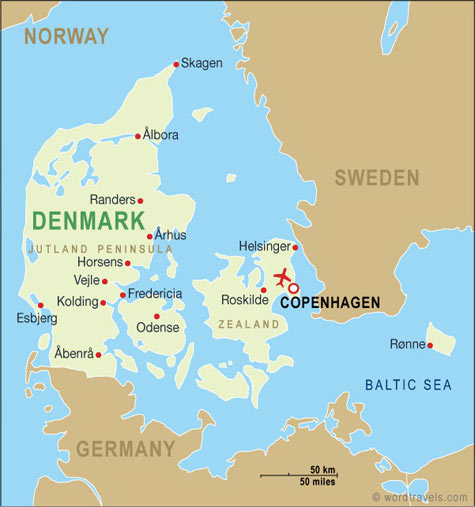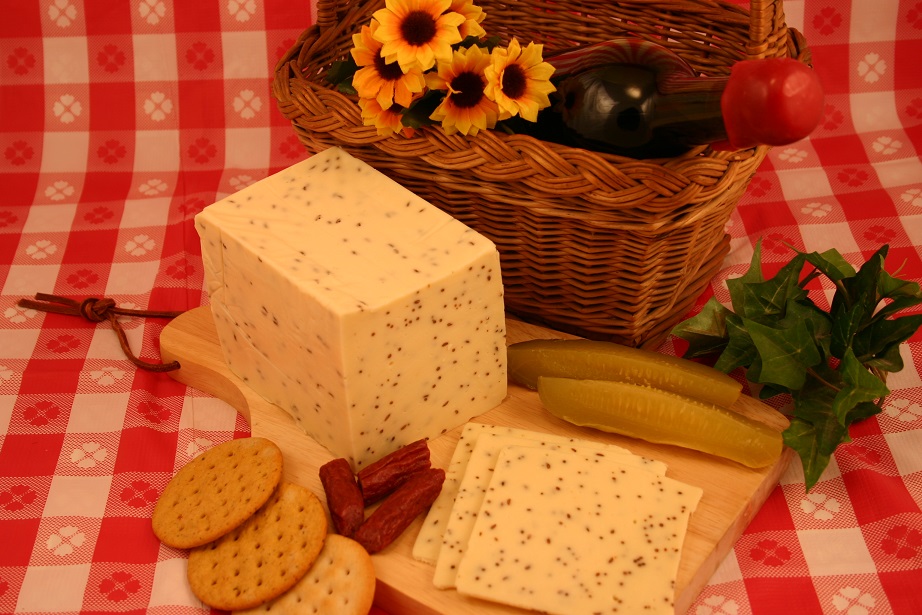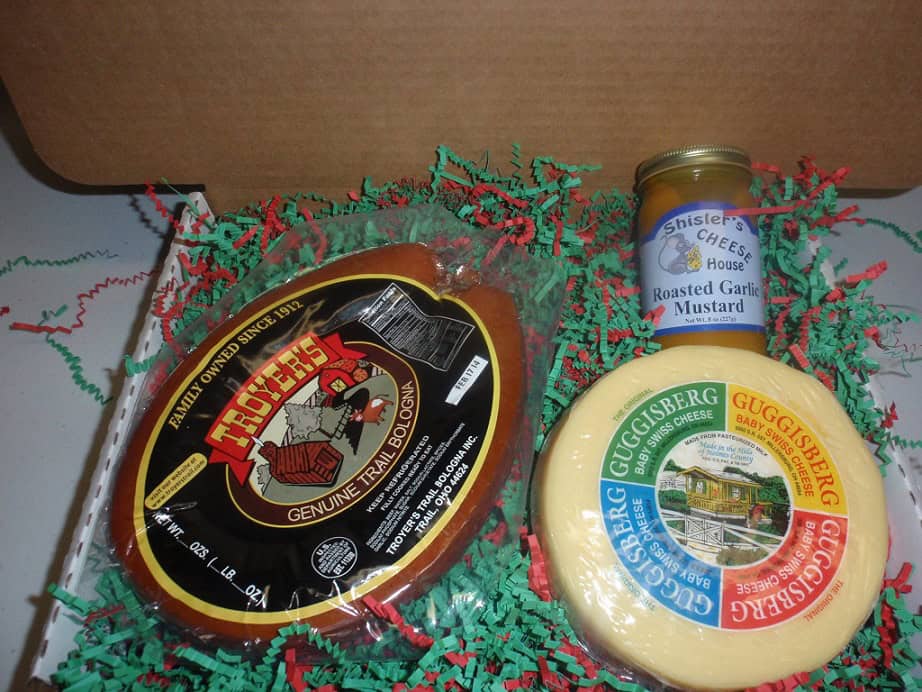Search Results for: swiss
Troyer’s Trail Bologna: An Amish Country Classic

Troyer’s Trail Bologna
Have you ever heard of Trail Bologna? We used to think everyone had. Passers-through never seemed to be able to get enough of it. But then we realized that it was only available in the local area. We have seen imitations in places like California and New Jersey with clever names like “Ring Bologna.” But this is a perfect example of one of those cases where nothing even comes close to the original: Troyer’s Trail Bologna.
Trail is capitalized because it is named after the tiny town of Trail, Ohio. Trail is so small that it does not even have it’s own zip code. It shares a zip code with the nearby town of Dundee, OH, and population statistics are not even available. Trail was so named because SR 515, the main road through the town, was originally a trail created by American Indians before the European settlers moved to the area. About the only thing in Trail Ohio today is the original production facility where Troyer’s Trail Bologna is made, complete with a general store where enthusiasts can buy all of the products Troyer’s offers, along with other local fare.
Michael Troyer began producing this bologna in 1912. He used a special blend of seasonings and unique wood smoking process to develop this chunky beef bologna with a rich smoky flavor. It was originally hand stuffed into casing and rolled into its hallmark “ring” shape. It is a common misconception that the Original Trail Bologna was made from Venison (deer meat). It is illegal to sell the meat of wild game, so the Original Trail Bologna is all beef. But the facility will process deer brought in by hunters using their unique methods. There is also a rumor that Michael Troyer purchased his recipe for $25 from another family in Trail named Weiss, who had already been producing the now famous bologna for some time. But that has never been confirmed.
Today, Kenny, Kevin, and Darrin Troyer run the facility with the same standard of quality that their great grandfather did nearly one hundred years ago. Of course the facility has evolved. The Trail Bologna is no longer hand stuffed and modern machinery has enabled them to keep up with the ever-increasing demand. The facility now produces an average of 50 tons of Trail Bologna per month, doubling that during the holiday season. But the standard of quality that made Troyer’s Trail Bologna famous has never faltered. All three brothers are still highly involved with the production process. They now offer their Trail Bologna infused with locally made cheddar cheese and hot pepper cheese. They also produce it in sandwich size logs suitable for slicing and enjoying on sandwiches. They even make a Turkey Trail Bologna for their more health conscious customers.
Troyer’s Trail Bologna is best enjoyed with Swiss Cheese, Baby Swiss Cheese, Cheddar Cheese, or Hot Pepper Cheese for those with a more daring palate. Local and tourist taste buds are intimately familiar with the unique flavor of Troyer’s Trail Bologna. Locals who move out of state often complain that they cannot find it anywhere else. It can be very difficult to find outside of the state of Ohio. Fortunately however, for those who are web-savvy, one local merchant is offering it nationwide over the internet at https://cheesehouse.com/troyers-trail-bologna.aspx
Enjoy the smoky flavor of Troyer’s Trail Bologna, an Ohio Amish Country original!
The Art of Cheesemaking
[youtube=http://www.youtube.com/watch?v=_hjYzEMf4ZY]
Here is a video demonstrating the difference in the Amish Cheesemaking process. Video footage courtesy of one of our principal local cheese suppliers, Guggisberg Cheese. Here are links to the cheeses described in this video:
Swiss Cheese
And you can find over 60 other cheeses, including several others produced by Guggisberg Cheese at: https://cheesehouse.com/cheese.aspx
Making Cheese The Amish Way
 We now live in a society whose greatest value has become productivity. We get our news from short sound bites from the internet or TV now instead of reading the paper. We rarely read books anymore. We listen to them while we are stuck in traffic, trying to get to work so we can get as much done in as little time as possible. The products we buy are made with the same goal in mind: maximum efficiency. But those who produce the few products that we still make in the U.S., whose ultimate goal is maximum efficiency, seem to have lost their standard of quality. They make it fast, but what happened to the concept of taking your time and doing it right? Some things just cannot be made fast without sacrificing quality.
We now live in a society whose greatest value has become productivity. We get our news from short sound bites from the internet or TV now instead of reading the paper. We rarely read books anymore. We listen to them while we are stuck in traffic, trying to get to work so we can get as much done in as little time as possible. The products we buy are made with the same goal in mind: maximum efficiency. But those who produce the few products that we still make in the U.S., whose ultimate goal is maximum efficiency, seem to have lost their standard of quality. They make it fast, but what happened to the concept of taking your time and doing it right? Some things just cannot be made fast without sacrificing quality.
One of those products is cheese. Mass produced cheeses all seem to have the same “tinny” metallic taste. That is because the manufacturers add chemicals to speed up the maturing process, but the residue from these chemicals creates that metallic aftertaste. The corporate manufacturers even rush the cows to produce more milk by injecting them with hormones and feeding them over processed feeds that are measured and distributed by computers. While these processes are efficient, we all agree that the quality suffers greatly.
Fortunately for cheese lovers, there is still a culture among us that believes in doing almost everything the old fashioned way: The Amish. Cheese making is a skill brought to Ohio by the earliest Swiss and German immigrants, and it still survives in Ohio Amish Country to this day.
Not only do the Amish have traditional knowledge and skill in the trade, there are numerous Amish dairy farmers in the area that provide the best possible milk. The cows are hormone free and they feed on natural grasses native to the valleys of northern Ohio that have never been sprayed with pesticides. The average Amish farm has only ten cows, so they can be more closely monitored. The milk is delivered to the cheese makers in numbered cans that can be traced back to the exact farm, and even the exact cow it came from. This provides a quality control system that prevents any sub-standard milk from entering the supply, but does not affect the distinctive Amish farming methods.
Cheese making is an art and a science, so some modern technology has been added to the final cheese production process to ensure a sanitary and healthful product. But the technology has all been carefully introduced so as not to affect the quality of the cheese. The milk is pasteurized to prevent the introduction of any foreign bacteria. The cheese is now made in stainless steel vats as they are easier to clean and more sanitary than the old copper kettles. The enzymes that are introduced to form the cheese curds are now more carefully measured to ensure the highest quality. No chemical preservatives are added, but the individual pieces of cheese are vacuum packed and refrigerated after the aging process is complete to ensure the cheese stays fresh until it makes its way to your table. All of this ensures an unmatched standard of quality.
Most Amish made cheeses have a cream content level of up to 33% milk fat, which is high compared to mass-produced cheeses, but that’s what makes them so creamy and full flavored. The cheeses are refrigerated during storage, but are best served at room temperature. There are over 50 flavors of cheese that are made in Ohio’s Amish country. The most notable are Amish Swiss, Sharp Swiss, Baby Swiss, Amish Butter Cheese, Colby, Farmers Cheese, Jack Cheese, Marble (Colby Jack), and Yogurt Cheese. They also produce numerous variations of each including smoked varieties and cheeses infused with peppers, onions, and bacon to name a few. A byproduct of the cheese making process is also butterfat, which is used to make Amish Butter, the best butter most will ever taste.
But the Amish level of patience and dedication does not only apply to dairy products. Their religion discourages them from worldly pursuits, so their ultimate goal in everything they do is perfection rather than profit. Their patience and dedication is evident in their other specialty foods including fruit preserves, pickled vegetables, and the specialty meats that they inspired. Anyone who has ever visited Ohio’s Amish Country has most likely seen the top quality bedding and furniture they have also become famous for.
For the cultural tourist, Ohio’s Amish Country is a must see. The cheese connoisseur need not leave his/her own living room. All of the cheeses and other delicacies mentioned are available over the Internet. But nothing compares to actually visiting and seeing the labor of love firsthand.
The Perfect Monte Cristo
One of my favorite sandwiches of all time has always been the Monte Cristo, a toasted turkey, ham, and swiss sandwich with a touch of elegance. I initially discovered it at Bennigan’s. I later tried several versions at Diners along the East Coast. The one thing that I noticed was that you must use the proper ingredients to make a great Monte Cristo. There is a delicate balance between sweet and salty, and skimping on the ingredients can throw the whole balance off and turn it into a boring ham and cheese sandwich.
So I did my research and found the following to be the best recipe for a delicious and elegant Monte Cristo. Most restaurants and diners deep-fry the sandwich, but this recipe enables you to prepare it in your own kitchen.
One important element is the proper Swiss Cheese. Do not use the processed swiss you find in the grocery store. One recipe I found even called for Gruyere. But that can be expensive and is a little sharp for my palate in this particular recipe. Amish Swiss cheese from Ohio’s Amish country works perfectly. The same rule goes for the meats. Use quality smoked ham and turkey, not the discount processed meats from the grocery store. You would also be surprised to see what a big difference high quality butter can make over margarine. I prefer salted butter, but some prefer unsalted instead.
The best place for the chef to get creative is with the jam. Traditional recipes call for strawberry or raspberry jam, and I even saw one that used red currant jelly. But you can make this recipe your own by serving your favorite jam. The importance of the jam is to provide the sweet side of the contrast. Again, make sure you use a quality jam and not a grocery store jelly. If you make your own jam, even better!
Here is the recipe for the perfect Monte Cristo. Leave out the turkey and it becomes a Monte Carlo:
Ingredients:
12 slices firm-textured white bread
12 thin slices swiss cheese
6 medium-thin slices Smoked Ham
6 medium-thin slices turkey
Mayonnaise
3 eggs
1/4 cup of half and half, light cream, or milk
Dash of salt
3 to 5 tbsp of butter
Powdered sugar
Parsley sprigs
homestyle jam (traditionally strawberry or raspberry)
Directions:
- Spread mayonnaise on one side of each bread slice and construct 6 sandwiches with 2 slices of cheese, one slice of ham, and one slice of turkey.
- Using a sharp knife, trim bread crusts and filling making sandwich edges even; cut each sandwich in half diagonally.
- Beat eggs, half and half, and salt until blended in a shallow dish. Place sandwiches in mixture and turn to coat; then let stand, turning occasionally until all liquid is absorbed.
- Melt 3 tbsp of the butter in a pan over medium heat. Add as many sandwiches as will fit without crowding. Brown lightly on both sides. Add butter to pan as needed.
- Place browned sandwiches on ungreased baking sheet and bake at 400º until cheese is melted (3 to 5 minutes)
- Sprinkle the powdered sugar onto the sandwich and garnish with parsley.
- Serve hot, accompanied by ramekin of jam. Makes 6 sandwiches.
Optional:
For the more daring chef, add a dash of cinnamon and a teaspoon of vanilla extract to the egg mixture.
Troyer’s Trail Bologna With Cheddar
The Original Troyer’s Cheese & Trail Bologna!
For three generations we at Shisler’s Cheese House have prided ourselves on providing the best examples of local fare to tourists and locals alike. Also, Troyer’s Trail Bologna is one of the best examples of local fare we can recommend. So, our Trail Bologna comes from the fourth generation of the Troyer family. Don’t be fooled by imitators. Also, there is only one Troyer’s Cheese & Trail Bologna, made in Trail, OH, and sold exclusively by Ohio retailers.
Now, thanks to the internet, Troyer’s Trail Bologna is available nationwide!
Troyer’s recently added Trail bologna infused with hot pepper cheese to their product offering. We are proud to carry both.
Troyer’s Trail Bologna rings make great gifts, either individually, or they are included in four of our Gift Boxes: Trail Bologna and Cheese, Baby Swiss Cheese and Trail Bologna, Amish Country Sampler, and The Cheese House Special. So, get something delicious for that special someone.
Description of Troyer’s Trail Bologna with Cheddar
Chunky bologna, made with coarse cuts of meat. Trail Bologna originates from the Troyer family in the tiny town of Trail, Ohio. One of the best flavors of Amish Country! Enjoy the smoky taste of Trail Bologna.
Not to be mistaken for the common Venison Trail Bologna, which was inspired by the original. Troyer’s Trail Bologna is all beef. Trail Bologna is usually sliced fairly thin and served on a platter with cubes of cheese.
History of Troyer’s Trail Bologna with Cheddar
Trail Bologna was named after Trail, a village in Ohio that is too small to have a zip code of its own. The Troyer family has been making their quality wood-smoked Trail Bologna here for four generations.
Starting in 1912, Michael Troyer created a unique blend of special seasonings to make his now-famous all-beef Trail Bologna. So, the family continues the tradition of excellence to this day by making literally tons of savory treats daily.
Though obviously no longer hand-stuffed, modern production methods have not altered the quality. It continues to be authentically wood-smoked for the same old-fashioned good-tasting Trail Bologna. Have any more questions about our cheese? If so, contact us today!

Troyer’s Trail Bologna With Hot Pepper Cheese
The Original Troyer’s Trail Bologna with Hot Pepper Cheese
For three generations we at Shisler’s Cheese House have prided ourselves on providing the best examples of local fare to tourists and locals alike. Troyer’s Trail Bologna is one of the best examples of local fare we can recommend. Our Trail Bologna comes from the fourth generation of the Troyer family. Don’t be fooled by imitators. There is only one Troyer’s Trail Bologna, made in Trail, OH and sold exclusively by Ohio retailers.
Now, thanks to the internet, Troyer’s Trail Bologna is available nationwide!
Troyer’s Trail Bologna rings make great gifts, either individually, or they are included in four of our Gift Boxes: Trail Bologna and Cheese, Baby Swiss Cheese and Trail Bologna, Amish Country Sampler, and The Cheesehouse Special.
Description of Troyer’s Trail Bologna with Hot Pepper Cheese
A chunky bologna, made with coarse cuts of meat. Trail Bologna originates from the Troyer family in a tiny town of Trail, Ohio. One of the best flavors of Amish Country! Enjoy the smoky taste of Trail Bologna.
Not to be mistaken for the common Venison Trail Bologna, which was inspired by the original. Troyer’s Trail Bologna is all beef.
Trail Bologna is usually sliced fairly thin and served on a platter with cubes of cheese.
History of Troyer’s Trail Bologna with Hot Pepper Cheese
Trail Bologna was named after Trail, a village in Ohio that is too small to have a zip code of its own. The Troyer family has been making their quality wood-smoked Trail Bologna here for four generations.
Starting in 1912, Michael Troyer created a unique blend of special seasonings to make his now famous all-beef Trail Bologna. The family continues the tradition of excellence to this day by making literally tons of the savory treat daily.
Though obviously no longer hand-stuffed, modern production methods have not altered the quality. It continues to be authentically wood-smoked for the same old fashioned good tasting Trail Bologna.

Havarti Cheese With Caraway
Havarti Cheese or Cream Havarti (Fløde Havarti in Danish) is a semi-soft Danish cow’s milk cheese. It is a table cheese that can be sliced, grilled, or melted. Havarti Cheese is made like most cheeses, by introducing rennet to milk to cause curdling. The curds are pressed into cheese molds which are drained, and then the cheese is aged. Havarti is a washed curd cheese, which contributes to the subtle flavor of the cheese.
Havarti Cheese is an interior-ripened cheese that is rindless, smooth and slightly bright-surfaced with a cream to yellow color depending on type. It has very small and irregular openings (“eyes”) distributed in the mass. Havarti Cheese has a buttery aroma and can be somewhat sharp in the stronger varieties, much like Swiss cheese. The taste is buttery, and from somewhat sweet to very sweet, and it is slightly acidic. It is typically aged about three months, though when Havarti Cheese is older it becomes more salty and tastes like hazelnut. When left at room temperature the cheese tends to soften quickly.
This variation of Havarti Cheese is infused with Caraway Fruits, commonly referred to as Caraway seeds, which are the principle element in the flavor of rye bread. The result is a pungent anise-like flavor and aroma combined with the rich and buttery flavor of Havarti Cheese. Plain Havarti Cheese and Havarti Cheese with Dill are also available. Havarti is also very similar in texture and flavor to our locally made Amish Butter Cheese.
History of Havarti Cheese
Havarti cheese was initially created by Hanne Nielsen who operated an experimental farm called Havarthigaard, in Øverød, north of Copenhagen, in the mid-19th century.

Wine Pairing for Havarti Cheese
Havarti Cheese Pairs well with several reds including Beaujolais, Cabernet Sauvignon, Pinot Noir, Merlot, and Zinfandel. If you prefer white wine, Sauvignon Blanc pairs well with Havarti Cheese. For beer drinkers, Havarti Cheese is nicely complimented with any Pilsner or Stout.
Havarti Cheese
Havarti Cheese or Cream Havarti (Fløde Havarti in Danish) is a semi-soft Danish cow’s milk cheese. It is a table cheese that can be sliced, grilled, or melted. Havarti Cheese is made like most cheeses, by introducing rennet to milk to cause curdling. The curds are pressed into cheese molds which are drained, and then the cheese is aged. Havarti is a washed curd cheese, which contributes to the subtle flavor of the cheese.
Havarti Cheese is an interior-ripened cheese that is rindless, smooth and slightly bright-surfaced with a cream to yellow color depending on type. It has very small and irregular openings (“eyes”) distributed in the mass.
Havarti Cheese has a buttery aroma and can be somewhat sharp in the stronger varieties, much like Swiss cheese. The taste is buttery, and from somewhat sweet to very sweet, and it is slightly acidic. It is typically aged about three months, though when Havarti Cheese is older it becomes more salty and tastes like hazelnut. When left at room temperature the cheese tends to soften quickly. Flavoured variants of Havarti Cheese are also available, such as caraway and dill. Havarti is also very similar in texture and flavor to our locally made Amish Butter Cheese.
History of Havarti Cheese
Havarti cheese was initially created by Hanne Nielsen who operated an experimental farm called Havarthigaard, in Øverød, north of Copenhagen, in the mid-19th century.

Wine Pairing for Havarti Cheese
Havarti Cheese Pairs well with several reds including Beaujolais, Cabernet Sauvignon, Pinot Noir, Merlot, and Zinfandel. If you prefer white wine, Sauvignon Blanc pairs well with Havarti Cheese. For beer drinkers, Havarti Cheese is nicely complimented with any Pilsner or Stout.
Havarti Cheese With Dill
Havarti Cheese or Cream Havarti (Fløde Havarti in Danish) is a semi-soft Danish cow’s milk cheese. It is a table cheese that can be sliced, grilled, or melted. Havarti Cheese is made like most cheeses, by introducing rennet to milk to cause curdling. The curds are pressed into cheese molds which are drained, and then the cheese is aged. Havarti is a washed curd cheese, which contributes to the subtle flavor of the cheese. Havarti Cheese is an interior-ripened cheese that is rindless, smooth and slightly bright-surfaced with a cream to yellow color depending on type. It has very small and irregular openings (“eyes”) distributed in the mass.
Havarti Cheese has a buttery aroma and can be somewhat sharp in the stronger varieties, much like Swiss cheese. The taste is buttery, and from somewhat sweet to very sweet, and it is slightly acidic. It is typically aged about three months, though when Havarti Cheese is older it becomes more salty and tastes like hazelnut. When left at room temperature the cheese tends to soften quickly. Plain Havarti Cheese and Havarti Cheese with Caraway are also available. Havarti is also very similar in texture and flavor to our locally made Amish Butter Cheese.
History of Havarti Cheese
Havarti cheese was initially created by Hanne Nielsen who operated an experimental farm called Havarthigaard, in Øverød, north of Copenhagen, in the mid-19th century.
 Wine Pairing for Havarti Cheese
Wine Pairing for Havarti Cheese
Havarti Cheese Pairs well with several reds including Beaujolais, Cabernet Sauvignon, Pinot Noir, Merlot, and Zinfandel. If you prefer white wine, Sauvignon Blanc pairs well with Havarti Cheese. For beer drinkers, Havarti Cheese is nicely complimented with any Pilsner or Stout.
Cyber Monday Special – $39.99 Shipping Included!
Cyber Monday Special – $39.99 Shipping Included!
1 1/2 Lb. Ring of Original Troyer’s Trail Bologna
2 Lb. Wheel of Baby Swiss Cheese
8 Oz. Jar of Shisler’s Private Label Mustard
Shipping will be via FedEx One Rate. No tracking information will be provided.Will be shipped separately from any other items ordered.









